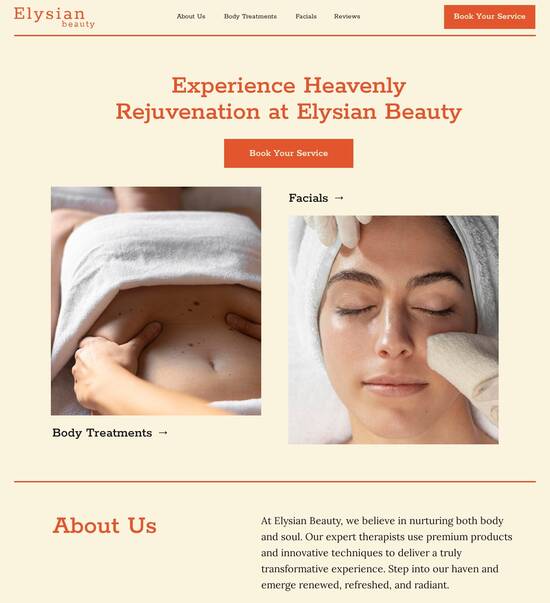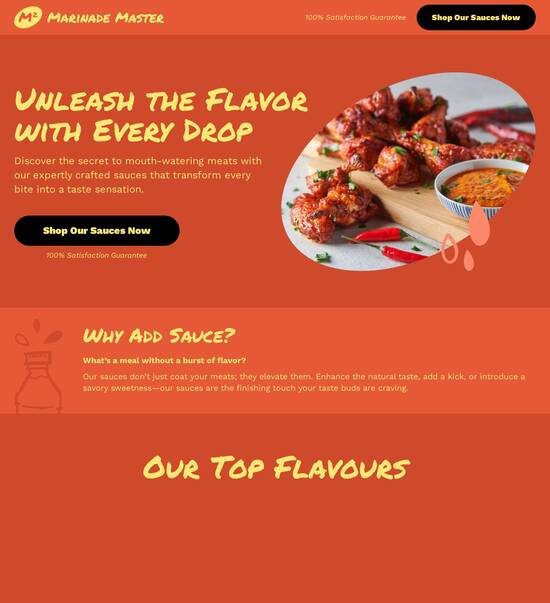
Shopping cart page template optimized for Apple Watch
Explore Similar TemplatesAbout template
Design using a responsive shopping cart page template that delivers a flawless experience on Apple Watch. Try Instapage today!
Recommended templates

Easy to build without coding
With the intuitive drag-and-drop builder, anyone on your team can create high-converting pages without any knowledge of code or design. Make enhancements to your landing page with custom widgets using Javascript, HTML/CSS, or third-party scripts.

Multiple layouts for any industry and goal
Select from 500+ landing page layouts built to boost conversions across industry-specific scenarios. Customize them by adjusting fonts, adding images, and generating on-brand content with the AI assistant. Quickly scale with Instablocks® and Global Blocks that you can save, reuse, and update globally.

Loads fast and looks polished on any device
Every template is responsive, which means they present professionally on any device and load blazingly fast with our Thor Render Engine. You can also power them up with Google AMP technology to deliver an unparalleled mobile experience and drive higher conversions.

Robust analytics & experimentation
Get real-time updates and reporting across all your devices, showing the number of visitors, conversions, cost-per-visitor, and cost-per-lead. Launch AI-powered experiments, run A/B tests, and use heatmaps to analyze user behavior, then optimize your landing page to maximize conversions.







Easy to build without coding
With the intuitive drag-and-drop builder, anyone on your team can create high-converting pages without any knowledge of code or design. Make enhancements to your landing page with custom widgets using Javascript, HTML/CSS, or third-party scripts.
Multiple layouts for any industry and goal
Select from 500+ landing page layouts built to boost conversions across industry-specific scenarios. Customize them by adjusting fonts, adding images, and generating on-brand content with the AI assistant. Quickly scale with Instablocks® and Global Blocks that you can save, reuse, and update globally.
Loads fast and looks polished on any device
Every template is responsive, which means they present professionally on any device and load blazingly fast with our Thor Render Engine.
Robust analytics & experimentation
Get real-time updates and reporting across all your devices, showing the number of visitors, conversions, cost-per-visitor, and cost-per-lead. Launch AI-powered experiments, run A/B tests, and use heatmaps to analyze user behavior, then optimize your landing page to maximize conversions.
All the features you need to build lead-generating landing pages
Explore more featuresLearn how to build top-performing landing pages for any goal
FAQs
Leading the way in building high-performing landing pages





A step-by-step guide to using Instapage for landing pages
If you're looking to enhance your digital marketing campaigns, utilizing Instapage's powerful landing page and CRO features can significantly boost your effectiveness. This guide will provide a step-by-step approach tailored for marketing professionals across various industries in the USA, focusing on how to maximize your returns with efficient landing pages that convert.
Understanding the importance of landing pages
Landing pages are crucial for capturing leads and driving conversions during your marketing campaigns. An optimized landing page serves as the first impression of your brand. By using Instapage, you can leverage over 100 high-converting templates designed to meet the demands of your audience while providing user-friendly features that require no coding.
- Focused Content: Each landing page is designed to speak directly to a specific audience, enhancing engagement.
- Optimized Design: Utilize templates that are tested for high conversion rates, ensuring effectiveness.
- Built-in Tools: With Instapage's integrated analytics, track visitor behavior and gain insights for ongoing optimization.
Creating your first landing page
To begin creating your landing page with Instapage, follow these initial steps:
- Choose a template: Start by selecting from over 100 high-converting templates tailored to various industries.
- Customize your page: Use the intuitive drag-and-drop builder to add elements specific to your campaign goals, such as forms, images, and call-to-action buttons.
- Integrate lead generation tools: Add pre-built lead generation elements that capture visitor information easily.
Optimizing for higher conversions
Once your landing page is live, the next step is optimization. Instapage offers several built-in features to help enhance performance.
- A/B Testing: Run experiments to test different versions of your page, allowing you to determine which elements perform best.
- Heatmaps: Analyze user behavior with detailed heatmaps that show where visitors are clicking and spending time on your page.
- Analytics Dashboard: Monitor key metrics to assess the success of your landing page and make data-driven improvements.
Personalizing user experiences
Lastly, personalizing content on your landing pages leads to higher engagement rates. Instapage allows you to ensure that the right message reaches the right audience through its personalization tools.
- Dynamic Text Replacement: Tailor content dynamically based on user input or session data.
- AdMap Integration: Align specific ads with corresponding landing pages to ensure a seamless transition.
- Audience Metrics: Track behaviors at the audience level to refine your approach.
By following these steps, you can create high-performing landing pages that resonate with your audience, optimize lead generation, and enhance your digital marketing campaigns.
Ready to transform your marketing efforts? Start creating powerful landing pages with Instapage today and see the difference it can make in accelerating your campaign success.
Shopping cart page template optimized for Apple Watch
The changing landscape of e-commerce and wearable technology
E-commerce has dramatically evolved over the past decade, primarily driven by the increasing ubiquity of mobile devices. As a significant percentage of consumers shift their buying habits to mobile platforms, businesses have begun to realize the importance of creating seamless shopping experiences on these devices. With the rise of wearables, particularly the Apple Watch, online shopping is seeing a transformation that accommodates quick, on-the-go purchases that previous formats could not. Today’s consumers expect not just convenience but intuitive shopping experiences that cater to their lifestyle.
According to market research, the global smartwatch market is expected to surpass 400 million units by 2025. A substantial proportion of these are Apple Watches, with latest data suggesting that over 50% of Apple Watch users are regular online shoppers. This surge highlights the necessity for e-commerce websites to optimize their shopping cart pages specifically for such wearable devices.
Understanding the unique needs of Apple Watch users
Apple Watch users are typically tech-savvy individuals who prioritize efficiency. They often seek quick solutions for their shopping needs, making them favor minimalistic designs that can be navigated easily. With screen dimensions considerably smaller than traditional devices, their behavior emphasizes the necessity for optimized experiences that promote swift decision-making through straightforward interfaces.
In contrast to desktop users who may browse leisurely, Apple Watch users expect an experience that caters to their fast-paced lifestyle. Common pain points include cumbersome navigation, excessive information overload, and complex checkouts. Addressing these issues is essential for retaining and converting these tech-driven shoppers.
The core elements of an optimized shopping cart page for Apple Watch
Creating an effective shopping cart page that resonates with Apple Watch users involves incorporating essential features that prioritize user experience. Here are the core elements that should be included:
Streamlined design for quick navigation: The layout should allow users to move swiftly through their carts without feeling overwhelmed.
Minimalist layouts that reduce clutter: Each component must have a purpose, ensuring that space is utilized judiciously.
Easy-to-access product information: Display critical details like prices and availability clearly, enabling speedy decisions.
One-tap functionalities for swift actions: Users should be able to add, remove, and change quantities with just a tap.
Legibility is crucial on small screens; hence, maintaining appropriate font sizes and touch targets ensures that users can interact seamlessly without unnecessary frustration.
Designing with purpose: Best practices for cart page design
An effectively designed shopping cart page must prioritize visual hierarchy to maximize engagement. This entails making critical elements like checkout buttons and product summaries more prominent while utilizing strategic spacing to avoid feelings of overcrowding. When it comes to color schemes and fonts, it’s essential to select shades that provide sufficient contrast for readability while sticking to larger, legible fonts that are easily discernible even in less-than-ideal lighting.
Responsive design remains integral across devices, and successful Apple Watch cart pages exemplify how elements can adjust fluidly. Coupled with a cohesive user experience, brands can create appealing designs that draw users in. For example, alert prompts and visual confirmations can enhance engagement and provide feedback on user actions.
Conversion rate optimization (CRO) strategies for small screens
Conversion Rate Optimization should be a continuous effort for businesses leveraging Apple Watch functionalities. Gathering concise customer feedback not only enriches the user experience but helps entrepreneurs to identify attributes that might require further enhancement. Engaging in A/B testing allows for experimenting with layout variations, fine-tuning elements like button placements to see what drives conversions effectively.
Moreover, integrating upsell and cross-sell strategies that are tailored for the Apple Watch user experience can further augment the AOV. For instance, prompting users with complementary items right before checkout can lead to increased sales margins. Personalization also plays a vital role; personalized recommendations based on previous purchases create a lasting impression, thus enhancing engagement and customer retention.
Streamlining the checkout experience on Apple Watch
A streamlined checkout process is imperative for ensuring a frictionless experience for Apple Watch shoppers. Simplifying payment methods is the first step, with integrations like Apple Pay allowing customers to complete transactions swiftly. Conceivably, the user experience can be further improved by ensuring a clear order summary is visible, keeping users informed about their purchases while maintaining context.
Moreover, offering a guest checkout option encourages those hesitant to create an account to proceed with their purchases without unnecessary barriers. Implementing quick checkout buttons can significantly reduce the time taken in the purchasing process, particularly in settings where users need to act fast.
Leveraging data insights for enhanced customer experience
Data analytics emerges as a powerful facilitator when enhancing the customer experience for Apple Watch users. Analyzing shopper behavior through effective metrics allows businesses to pinpoint potential drop-off points within the cart process. This understanding leads to improved retention strategies as it directly informs areas of focus that require enhancement.
Furthermore, cohort analysis can unveil diverse customer segments and their unique preferences. By tailoring the shopping cart experience based on insights gleaned from different demographics, brands can better cater to the needs of their varied customer base, ensuring relevance and relatability in their offerings.
Addressing security and trust factors
In the world of e-commerce, trust builds lasting relationships with clients. Displaying trust symbols, such as secured payment markers, not only boosts confidence but reassures buyers of their transaction safety. For users shopping on their Apple Watch, where screens are tiny, it's paramount to communicate these trust factors clearly and concisely.
Coupled with this, implementing robust security measures tailored to transaction-specific protocols via wearable devices builds a foundation of reliability. Educating customers about privacy arrangements and data protection regarding their Apple Watch usage is also essential for instilling a sense of safety during their shopping experience.
The future of e-commerce shopping carts: Trends and innovations
As technology continues to evolve, the future of e-commerce shopping carts is poised for exciting advancements. One such potential innovation involves the integration of AI and machine learning, allowing for adaptive approaches to customer behoeften and preferences. Predictive analytics could transform shopping experiences by curating selections based on users' past interactions.
Moreover, the advent of voice-activated shopping experiences on the Apple Watch could herald a new era in convenience, allowing for hands-free purchases that cater to busy lifestyles. As these advancements unfold, they will redefine how consumers interact with brands and ultimately reshape the e-commerce landscape.
Case studies of innovative businesses leading the charge
Companies such as Nike and Starbucks have successfully integrated Apple Watch capabilities into their shopping cart experiences, showcasing designs that prioritize user comfort and efficiency. With metrics indicating increased customer satisfaction and sales, these brands have illustrated what strategic optimization can achieve.
By analyzing these innovative brands, one can glean vital lessons regarding user-centric design principles and the critical need to respond to consumer behavior. Their success relies on a commitment to ongoing refinement based on metrics and feedback, creating a roadmap for others in e-commerce to follow.
Creating a winning strategy for your business
To optimize a shopping cart for Apple Watch, businesses need a clear strategy that reflects their goals. This starts with aligning cart optimization efforts with overarching business objectives and considering how these relate to customer experiences. Collaborating with skilled developers and user experience designers is vital to ensure that the vision translates effectively into user-friendly designs.
Regular assessments and adjustments based on user behavior can further inform and refine strategies over time, leading to a lasting impact on conversions and customer loyalty.
Final thoughts on embracing the future of wearable e-commerce
Adapting to technological advancements and changing consumer behaviors is critical for long-term success in e-commerce. Optimizing shopping carts for Apple Watch is not just an innovation; it reflects a proactive approach to catering to modern shoppers who desire fast, efficient, and secure shopping experiences.
By investing in optimization strategies, brands can significantly enhance user satisfaction and build trust, ultimately driving sales and fostering customer loyalty in an ever-evolving retail landscape.
Ready to skyrocket conversions?
Supercharge your ad campaigns with high-performing landing pages
Get started














